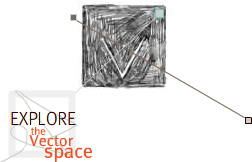Blue Velvet
Re-dressing New Orleans in Katrina's wake
Design by Erik Loyer
Editor's Introduction
This is not the first appearance of Hurricane Katrina in the databases that underwrite Vectors. For the past two years, we at the journal have returned more than once to Katrina and to the cityscapes of New Orleans. We are intent both on keeping the city and its ongoing struggles in scholarly view and on exploring the possibilities for multimodal expression to capture the complex histories interlaced in what our government would have us believe was simply an act of nature. "Blue Velvet: Re-dressing New Orleans in Katrina's Wake" represents our most sophisticated exploration of this terrain. Combining sound, text, photography, video, and several maps, the piece sculpts an evocative and poignant landscape that nonetheless refuses all registers of nostalgia, insisting as it does that we locate Katrina and the Crescent City among multiple trajectories of policy, memory, and representation.
While the piece proceeds via a loose linear structure, Goldberg, Hristova, and Loyer complicate this linearity via a logic of accretion and sedimentation. Meaning shimmers and dissolves, responding to the mouse and accumulating elsewhere, asking the user to follow its twists and turns into darker places. Words break apart but also serve to reorient us, allowing both drift and continuity. Such an information architecture serves to reinforce key claims of the project, foregrounding the reality of, for instance, a structural racism that always seems to disappear from view, connecting the dots between life in New Orleans and the growing prison population of the United States. As Goldberg observes, "Incarceration has many modalities."
It is crucial that we continue to underscore - as "Blue Velvet" so powerfully does - that the tragic events that unfolded in New Orleans and along the Gulf Coast were possible precisely because of years of neoliberal policies that underwrote the necessary conditions for such devastation in the first place. Likewise, the decision to invade Afghanistan and Iraq directly impacted ongoing efforts to repair the city's levees, with pursuit of empire trumping domestic infrastructure and safety. Several non-profits estimate that the cost of one day of the war in Iraq for the U.S. is $220 million. The cost of the war for one day would almost have completed the levee repairs begun in Louisiana in the years before Katrina. The poetic pace and haunting spaces of "Blue Velvet" take us closer to that truth than any evening spent with CNN.



